Sarah Harper Angers
September 2018
France: Brittany, Normandy, and the Loire Valley
My name is Sarah Harper, and I am studying abroad in Angers France for the Fall semester of my junior year. I am working toward a supplementary major in French, so, of course, France is the perfect place to help me become fluent in French. My primary major is Art History, so I enjoy visiting the different cultural sites such as palaces and museums. I am living with a host family, so I am always surrounded by the French language. During the month of September every student takes an intensive French language course, so this month I have focused on honing my French language skills. I am studying at the Catholic University of the West and meeting people from all over the world.
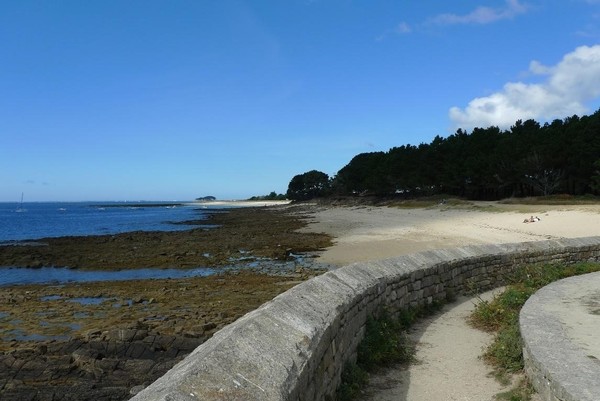
Angers is a lovely historical city with its very own castle which has no less than seventeen towers! Angers also showcases an impressive art collection. The Castle safeguards “The Tapestry of the Apocalypse” which tells the story of the Book of Revelations in the Bible. The tapestries are very expansive and make quite an impression. Angers is also very proud of one of their most distinguished citizens, Pierre Jean David d’Angers. D’Angers was a sculptor during the early 19th century and he is most known for sculpting the pediment for the Panthéon in Paris. Angers has a museum dedicated to their local hero containing both originals and copies of his works including a mold of the Panthéon’s pediment and a mold of the Gutenberg Monument in Strasbourg. D’Angers also created many busts and medallions of the most famous people of his time, including Victor Hugo and the artists Eugene Delacroix and Theodore Gericault. The ceiling of the museum is mostly made of glass, so the space is bathed in light which creates a dramatic atmosphere for viewing his artwork. Angers also boasts an impressive collection inside of its Museum of Fine Arts. The small museum holds artwork by famous French artists such as Jean Auguste Dominique Ingres, François Boucher, Theodore Gericault, Jean Honoré Fragonard, and Antoine Watteau. I enjoyed walking through this museum and soaking in all of the art within its walls.
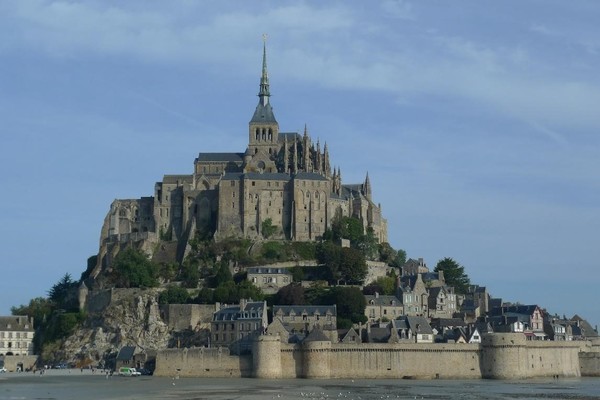
During the weekends my program has hosted trips to different locations throughout France. The first weekend we ventured to Mont Saint Michel. Mont St. Michel is an old abbey that is located just off the coast of Normandy. It was created as a very secluded island reserved for prayer. Today it is a stunning historical monument and one of the most visited sites in France. We explored the abbey and saw the cathedral as well as the place where the monks used to work and pray. We also walked around the town. After Mont Saint Michel we traveled to the town of St. Malo in Brittany. There is a wall surrounding the town of St. Malo that people can walk on. It was really beautiful to see the town from above. Crepes and galettes (savory crepes) were invented in Brittany, so of course we enjoyed delicious galettes for lunch.
The next weekend we journeyed back to Brittany, but this time we went to the Golfe of Morbihan. We took a boat ride across the golfe and then picnicked on a beach. The beach was stunning. We had just enough time to take a short nature walk across the beach searching for shells and little critters that washed up on the shore. We also saw the prehistoric Carnac Megaliths. It was interesting to see all of the different sizes and the organization of the megaliths. We ended the visit by stopping by the town of Vannes where we ate crepes and walked around the beautiful gardens.

The third weekend we traveled around the Loire Valley. We visited the Chateaux of Chenonceau. Henri II gave Chenonceau to his mistress Diane de Poitiers, however, after Henri died, his wife, Catherine de Medici, kicked Diane out. Catherine is the one who decide to construct the iconic bridge gallery. Chenonceau is a gorgeous chateau as both its gardens and interior décor are stunning. We then journeyed to the town of Amboise where I was able to see Clos Lucé with a couple of friends. Clos Lucé is the house where Leonardo da Vinci spent the last two years of his life. We then traveled to the chateaux of Chambord. Chambord was built by François I as a hunting retreat. It is famous for its double helix stair case. It is a large chateau and has beautiful grounds as well as a very interesting interior.
So far, my stay in France has been truly amazing! I have seen a lot of incredible art and my French is improving daily. I plan to continue seeking out opportunities to study art and to explore France.
October 2018
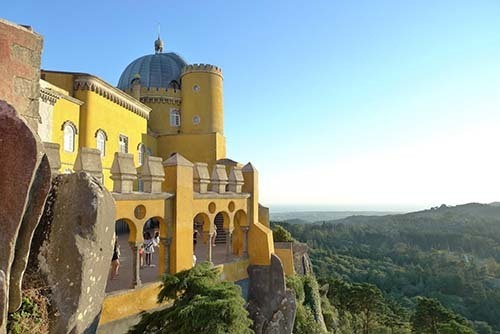
Before my classes began in October, I enjoyed a one-week vacation with friends where we visited Portugal and Spain. We did not spend a lot of time in any one place, but everything we saw was incredible. In Portugal we visited many beach towns including Lagos where we went sea kayaking around very beautiful rock formations. Our last stop in Portugal was Lisbon which is a colorful and historic place. From Lisbon we took a short trip to Sintra where we saw the Pena Palace! The palace was truly remarkable. It is located on top of a hill, so the views are fantastic. The palace is painted yellow and red making it instantly recognizable and it is very unique as it is one of the best examples of romantic architecture. We were lucky enough to catch the sunset while we explored the palace. We then returned to Lisbon and ate authentic Portuguese food.At the end of September, I finished the one month intensive course in Angers, so with the beginning of October came the beginning of a normal college schedule. All of my classes are in French, so I am challenged on an everyday basis. I am taking a few French courses in addition to art history, French history, and philosophy. Philosophy is definitely the most challenging course as the subject matter can be complicated for me even when it is in English. I have less time now that my regular classes have begun, but I still have plenty of time to explore France.
After Portugal we traveled to Madrid and Barcelona. In Madrid, I had the wonderful opportunity to visit the amazing Prado Museum where I saw some of the most famous paintings in the world including Las Meninas by Diego Velazquez and The Garden of Earthly Delights by Hieronymus Bosch. I had a wonderful time showing my friends around the museum and explaining the different time periods and artists. The last stop was Barcelona. In Barcelona we visited the Basilica of the Sagrada Familia which was designed by Antoni Gaudi. The Sagrada Familia is one of the most incredible pieces of artwork I have ever seen. Every detail is well thought out and beautifully executed. Especially for Christians the Sagrada Familia creates a truly amazing experience as it is impossible not to contemplate God’s majesty there. My fall break was filled with new adventures, many of which I never thought I would have the opportunity to experience in my lifetime.
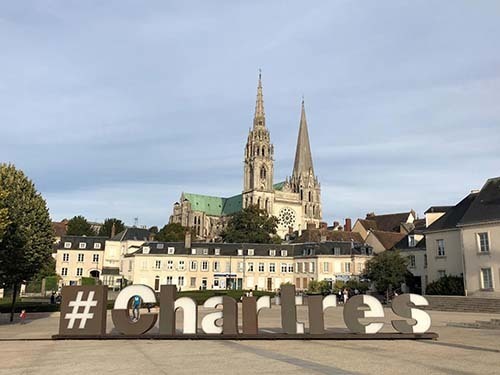
After fall break, I have been able to explore more of France on the weekends. I took a day trip with friends to Chartres, France where there is a famous cathedral, Notre Dame de Chartres. Chartres is one of the best examples of gothic architecture in the world. Chartres also boasts an impressive collection of original stained glass. The cathedral is truly stunning especially because the restoration is almost complete. The contrast between the areas that have been restored and the areas that have not is startling. In the areas that are not restored, the dirt and grime bathes the walls creating an extremely dark and heavy atmosphere. In contrast, the restored walls are bright and welcoming. The stained glass is gorgeous and depicts many scenes from the Tree of Jesse to the Passion. I also saw the Tunic of the Blessed Virgin which is Chartres’ most famous saint relic. The tunic was worn by Mary when she gave birth to Jesus. I am very glad I was able to visit such an important cathedral. After we sufficiently explored the church, we explored the town. It is a very cute town with a beautiful stream and nice shops.
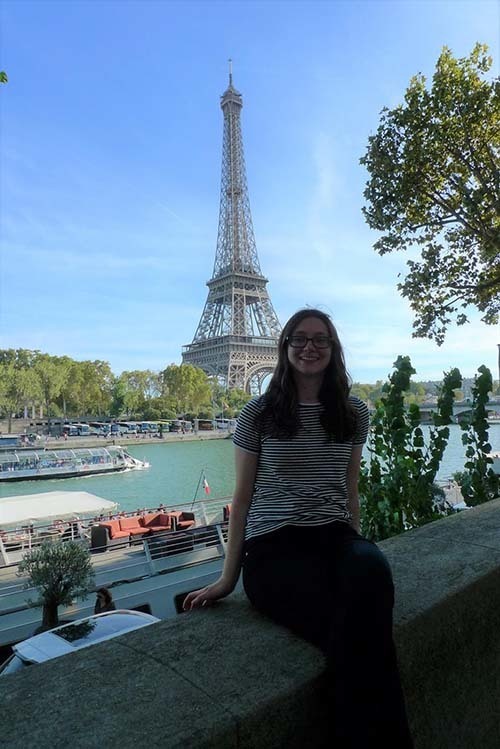
The next weekend I took a bus to Paris. Paris was stunning. The first Paris museum I visited was the Centre Pompidou because the friend I was travelling with had already been to the Louvre and the Musée D’Orsay. The building greatly stands out because it has a somewhat inside out construction. What I mean by that is that one can see the functional piping of the building from the outside. It is also interesting because the elevator and escalators are attached to the outside of the building but are under glass, so visitors can see the city all around them as they climb further up. The collection at this museum was incredible as well. That evening my friend and I stumbled into a light show that was being performed on the façade of the Notre Dame cathedral. It was a beautiful show and a memorable experience. The next day we visited the Saint Chapelle which is a chapel that was created by King Louis IX as a reliquary to house the crown of thorns. The walls of the chapel are almost entirely made of stained glass, so it is a truly marvelous building. We ended our trip by wandering the streets of Paris, which was perfect.
Throughout October I traveled throughout the Iberian Peninsula and was able to dive deeper into France. I saw many unforgettable things and had many unique experiences. I cannot wait to see what November has in store for me!
November 2018

Since France is a historically Catholic country, most French people have at least a long weekend for All Saints Day, so I began November with a four-day weekend. I decided to visit Dinan, a small town in Brittany that has one of the best-preserved Medieval town centers in France. My host family is also hosting a Japanese student, Kento, so Kento and I decided to travel to Dinan together. The town was very beautiful and tranquil. We loved exploring the old churches, St. Malo and the Basilica of the Holy Savior. The Basilica was particularly interesting because its architecture and interior elements represent many different eras. For example, the church was built in 1120 and was a Romanesque styled church, but it went through modifications in both the 15th and 16th centuries, so it also contains elements of gothic architecture. The stained-glass windows are modern and the architectural element over the altar also looks more modern but with Baroque tendencies. The basilica was a wonderful mix of different time periods and it was fun to figure out which time period each piece came from.
Dinan also boasts a medieval port off of the Rance river. We were there on a bright day and the water was perfectly still and very reflective. We hiked around the valley and saw some beautiful trails. We also walked to the nearby town of Lèhon where we explored an old Abbey. We had a nice relaxing vacation and went back to Angers ready to continue our school work.
Kento himself presents an interesting challenge for me as well because Kento is currently at a lower level of French than I am, and he does not speak English well. As a result, I speak almost exclusively in French with him. I really enjoy speaking with Kento because I am able to help him with his French while reinforcing my own French. I am also practicing patience because sometimes it is very difficult to express a specific thought to him and vice versa. It is amazing how we have been able to get to know each other without really being able to hold a complex conversation. I have also learned about Japanese culture through Kento, so he has helped me look past the western world. I also have a friend from class who is Taiwanese, and she is trying to pass an English language exam so that she can apply for a job in an English-speaking country. She came to me to help her with her writing in English. I really enjoyed being able to help someone with their English and I learned a lot as well. I found myself passing along to her suggestions that French teachers and professors have given me, so now I have a little bit more insight when it comes to the errors I make when writing in French. It is really an incredible experience to be friends with people from all over the world.

In November I also took advantage of the excursion offered by my program to visit the chateau of Versailles. As an art history lover and French enthusiast, I was excited to see Versailles and it did not disappoint. We walked through the incredible palace admiring all of the decorations and the overabundance of gold. The ceilings were wonderfully painted, and to my surprise there were many rooms dedicated to France after the revolution including the Napoleonic wars. The gardens were also very pretty, though because we went in November, most of the plants were already in hibernation. So instead of truly admiring the gardens, we walked to the Petit Hamlet, which is where Marie Antoinette pretended to be a peasant woman. The cottage was straight out of a fairy tale, so it was a wonderful place to walk around, but it also reminded us that Marie Antoinette was sadly very ignorant of the suffering of her people.

Finally, I also had an opportunity to visit the Louvre for the first time. Visiting the Louvre has been one of my dreams since elementary school, and it was just as incredible as I have always imagined it, and even more so. For an art history major like me, there are not many museums that can compete with the Louvre’s collection of masterpieces. There was one room where I realized that I had studied in some capacity almost every single painting in that room. It was an amazing experience and I definitely need to return because no one can see the entire Louvre and fully appreciate it in just one day.
In November, I was able to get to know a small town in France, mark two palaces off of my bucket list, and meet amazing people from all over the world. My experience in France has been overwhelmingly positive and there are opportunities for me to grow and develop as a person around every corner.
December 2018

Spending part of the Christmas season in Europe was truly a blessing. I began the month of December strong by traveling to Strasbourg which is known as the “Capitol of Christmas.” Christmas in Strasbourg was stunning. The entire downtown area was closed off to vehicles, so we could roam freely through the Christmas markets. Lights were hung across every street, decorations covered every building, and, of course, there was the giant Christmas tree dominating le Place Kleber. One portion of the town center known as the “Carré d’Or” or “Square of Gold” is decorated with a different colored theme each year. This year the theme was white, so we saw all sorts of polar bears, icicles, and snow. The first time I saw the cathedral, Notre Dame de Strasbourg, I think I let out an audible gasp. The cathedral dominates over the square making it a very imposing structure, and it is simply stunning. The interior of the Cathedral is just as impressive as the outside, and I particularly enjoyed their nativity scenes. It was a beautiful set starting with the Annunciation and ending with the Epiphany.

Growing up in a suburb of Chicago, I always loved traveling downtown to visit Chicago’s Christkindl market. After knowing and loving the Chicago market, I knew I wanted to see some true European ones, and Strasbourg’s markets are certainly some of the best. The scent of “vin chaud” or mulled wine filled the air, and there were plenty of beautiful products on display. Strasbourg is located in the region of Alsace which is the region of France that shares a border with Germany. The region has also changed hands between Germany and France many times in the past. As a result, the culture, while still technically French, has a lot of German elements. The French accents resemble German accents, many of the signs and names of buildings use German, and their food often resembles German cuisine. One example of a specifically Alsatian food with German roots is the Bretzel. And, no, I did not just spell “pretzel” incorrectly. The Alsatian Bretzel is basically a pretzel but it is made using a different baking process which makes it unique and the Strasbourg markets were full of this special treat.
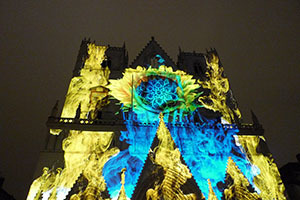
Strasbourg was truly amazing, and the next weekend I traveled to another amazing city, Lyon. I was lucky enough to have the opportunity to visit Lyon during their Festival of Lights which coincides with December 8th, the day of the Virgin Mary’s Immaculate Conception. During the Middle Ages when the black plague ran rampant, the citizens of Lyon were understandably concerned. They prayed for intersession to the Blessed Virgin Mary to save them from the plague, and miraculously, they were indeed saved from the plague. As a result, from the Middle Ages to this very day, the Lyonnaise people have set out lights every year as a way of giving thanks to Mary. Today the tradition of displaying lights to honor Mary has become a full-blown festival of lights featuring shows and displays. It was amazing to see the city come to life at night as thousands of people roamed the streets enjoying the spectacular light displays. One of the displays even traversed the river and covered three different buildings across the river. It was a magical experience. By day, the city became much calmer. My favorite daytime activity was visiting the Museum of Fine Arts. It was a wonderful museum with a very impressive collection. One of the main reasons I wanted to venture to Lyon was to see a very specific painting located in this museum. The painting is “A Woman Suffering from Obsessive Envy” and it is one of the five remaining paintings from the series “The Portraits of the Insane” by Theodore Gericault. Gericault was a Romantic artist from the early nineteenth century. He is most well-known for his painting “The Raft of the Medusa.” The “Portraits of the Insane” were some of the last paintings he completed before his untimely death at age 33. My favorite “Portrait of the Insane” is “Envy” because of the redness around the figure’s eyes and her slightly menacing expression. I was very happy to finally be able to see a painting in real life that I have admired for a long time.
Luckily, I remained safe traveling in France during the month of December. I did not run into any real problems, but unfortunately, there were many concerning situations that occurred in

December in France that effected travelers. The first problem was the protests by the “Gilet Jaune” or the Yellow Vests. The Yellow Vests consist of mostly lower-class workers. They were protesting a tax increase on gas implemented by President Macron. These tax increases while only slightly inconveniencing those from a higher economic class, were particularly difficult and ultimately the last straw for people with lower incomes. For example, the tax affects those living in the countryside more severely than those living in big cities because those living in the countryside must use vehicles to perform their farming jobs. The protests started out very calm. The Yellow Vests would only inconvenience drivers. However, after a week or two, the protests became more violent, but interestingly only in Paris. Unfortunately, the Paris protests got out of control. The protestors began burning cars, graffitied the Arc de Triumph and broke into shops and stole millions of dollars in merchandise from the designer stores on the Champs de l’Éylsées. It was unacceptable behavior and the Police were forced to take severe measures to counteract it like using tear gas. But what I would most like to focus on is how contained these protests were. Yes, the Champs de l’Éylsées was extremely dangerous during these protests, but the rest of Paris was doing just fine. I had a friend who was visiting Paris that weekend and she easily avoided dangerous situations simply by avoiding the contained violence in the center of the city. The media made it sound like all of France was in chaos, when it was only a small, albeit iconic, part of Paris that had descended into chaos. Throughout the rest of France the Yellow Vest protests continued just as they had before in a controlled manner. In fact, many French people will tell you that the people who destroyed the property in Paris that day were not even real Yellow Vest protestors and that they just used the Yellow Vests as an excuse to create chaos and cause destruction. It was very interesting to be in France during these protests to see how the French people deal with controversy. The experience helped me understand that the media does not always explain the entire truth of a situation.
The other major problem that occurred in France during December was the terrorist attack at the Strasbourg Christmas Market. I was shocked by the horrible news as I had just enjoyed wonderful trip to Strasbourg the week before the tragedy. It deeply saddened me that attacks such as this continue to happen. The problems in France, while horrific, have helped me learn even more about France including how well the French people deal with controversy and tragedy.
January 2019

There is not a whole lot to do in France in January. People are recovering from the busy Christmas season, so a lot of places are closed and there are not very many tourists around. The first weekend back after I returned to France, I went to Bayeux with my friend Maggie, who is also staying in Angers for the entire school year. Bayeux is a small town in Normandy and it is home to the famous Bayeux tapestry. We traveled all the way to Bayeux just to see the tapestry, and when we got there, we found out that for the first time in almost one thousand years the tapestry had left Bayeux and was currently residing in England for the month of January. While this was a major disappointment, we enjoyed touring the rest of the town. We walked around and visited a British D-Day cemetery.
At the end of the day, when we were supposed to head back to Angers, we found out that our train was severely delayed. Bayeux is a small town, so we had to take three trains from Angers to get there. This delay, caused by the “Yellow Vests” shutting down the train station in nearby Caen, caused us to miss our transfers. Luckily, there was a train traveling to Paris from Bayeux. People working in French service industries are known to be difficult to deal with, but when we asked the station’s agent, he did not give us any trouble regarding a ticket exchange. He very quickly and easily changed our tickets without any extra cost to us. So, we had to stay the night in Paris to be able to return to Angers in the morning, but luckily, we had a friend, Annie, who was willing to lodge us for the night in Paris. Due to the generosity and patience of these two people, Maggie and I were taken care of and did not have to worry about spending the night in an unknown town.

The next weekend we purposefully planned a trip to Paris. We once again met up with our friend Annie and we all enjoyed a day filled with museums. We went to the Delacroix Museum which is the former homoe of Eugene Delacroix, a famous Romantic painter of the 19th century. As an admirer of Delacroix, I was amazed to be walking through the same halls he once walked, and I was interested to see the very tools he painted with which are housed there. We then toured the Louvre where we saw Delacroix’s masterpieces, Liberty Leading the People, The Death of Sardanapalus, and The Massacre at Chios. In the same room we also saw the masterpieces of Theodore Gericault, The Raft of the Medusa, The Wounded Cavalier, and The Charging Chasseur. This particular room was closed last semester due to renovations, so I was very excited to finally see all of these amazing paintings in real life. The next day we visited the Musée Rodin, which, like the Delacroix Museum, is a former residence and studio of an artist, in this case, the sculptor Auguste Rodin. Rodin is the most celebrated French sculptor of the 19th century. He created timeless works such as the Gates of Hell and The Thinker. The museum and gardens were lovely to walk through, and there was also a wonderful special exhibition focusing on Rodin’s water colors being held on the grounds. Rodin studied movement very carefully so that he could incorporate it precisely into his sculptures. His watercolors sometimes served as studies for his sculptures.
Because Maggie and I decided to stay in France for the entire school year, our Fall courses continued into January and, as a result, we spent the last weekend of the month studying for finals in Angers.

The most exciting part about my January in Angers, was that I started an internship at the Chateau of Angers. Last semester, I emailed a few people at various art and cultural sites in Angers asking if they wanted any help for the spring semester. The Chateau responded immediately and asked me if I wanted to translate exhibition texts into English. I then went through a process of filling out paperwork and securing an internship at the Chateau. So, the day I returned to Angers following Christmas break, I began working at the Chateau. The internship has been challenging. I must work to translate French words and phrases that do not have direct correlations in English. As a result, I work closely with my boss, Catherine Leroi, to come up with solutions that will maintain the integrity of each sentence. Sometimes, it is challenging just to communicate with the museum staff because French is my second language and English is their second language, but we are always able to find a solution in the end. The texts I am working on translating are for a special exhibition opening at the Chateau in June comparing Warrior Saints to modern day Superheroes and Manga heroes. The texts are very interesting, so I am not only learning a lot of French, I am also learning a lot about the medieval mindset regarding warrior saints, and I am gaining valuable insight into how a special exhibition is run. It is pretty amazing that I am contributing to an exhibition to be held at a chateau that has been around for hundreds of years.
This January has been full of many ups and downs. I learned that one should always be prepared for the unexpected while traveling and always check travel plans ahead of time. I have learned about the inner workings of museums and discovered and overcome challenges while translating texts. January has been a true learning experience.
February 2019
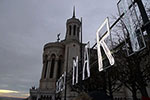
My Fall finals ended the last week of January, so I began February with a week-long break. My friend, Maggie, and I decided to travel to Prague, Vienna, and Budapest to discover more of central Europe. We spent about two and a half days in each city, and our first stop was Prague. On our first day in Prague we walked across the famous St. Charles Bridge and saw the Old Town Square. The oldest functional astronomical clock in the world is in the Old Town Square and it performs a “show” on the hour every hour. After watching this “performance,” we walked to a nearby restaurant to eat a traditional Czech meal. We enjoyed a delicious meal of Czech roast duck with red cabbage and potato dumplings. I wanted to see “The Slav Epic” by Alphonse Mucha, but unfortunately it was not on view anywhere in the city, so we went to the Mucha Museum instead. Mucha was one of the most important artists of the art nouveau movement during the early 19th century. He was Czech but he is most famous for his work in Paris which is where he created many posters for theatrical events. The Mucha Museum was a beautiful little museum and I really enjoyed learning more about such an important Czech artist. After the Mucha Museum, we visited the historic Wenceslas Square and then ventured into the Franz Kafka Museum which was an interesting experience because I did not know much about Kafka before visiting this museum. We also saw several sculptures by the artist David Černý which were situated throughout the city. Černý is a contemporary artist who creates controversial works and the most controversial piece we saw is called “Piss” and it consists of a fountain with two men peeing onto the outline of Czechia. It is situated outside of the Kafka Museum. That evening we attended the opera, “The Magic Flute” at the Estates Theater which is where the opera “Don Giovanni” premiered.
The next day it snowed in Prague, so we had the opportunity to experience Prague as a winter wonderland, and it was truly gorgeous. We climbed a snowy hill to the Strahov Monastery where we saw a preserved dodo bird and two beautiful libraries, a theological library and a philosophical library. From outside the monastery we enjoyed a great view of the city. We then went to Prague Castle where we toured St. Vitus Cathedral (which contains a beautiful stained-glass window designed by Alphonse Mucha) and saw St. Wenceslas Chapel. We also saw a portion of the castle which included the window where the defenestration of Prague occurred. The rest of the day we walked around and once night fell, we climbed to the top of the astronomical clock tower in Old Town Square to view the city at night. Our last half day in Prague we walked to the Jewish Quarter and toured the Jewish Museum. We saw a touching memorial to the victims of the Holocaust and visited three different synagogues. We then got lunch and took a train to Vienna.
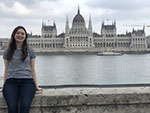
In Vienna we took advantage of many of cultural activities. We began our first day by eating breakfast at a café. Café culture in Vienna is very important, so it was interesting to observe all of the people relaxing and reading their newspapers. After our breakfast, we visited the Belvedere Palace, which is now an art museum. We saw many famous artworks, the most famous being “The Kiss” by Gustave Klimt. It is a magnificent painting and seeing it in person is an especially poignant experience because the gold he used in the canvas actually shimmers in real life. After touring the Belvedere, we walked around the beautiful city and eventually found ourselves sitting in a café across from the Vienna Opera house, so we decided to see if there were any affordable tickets available for that night’s performance. We went inside the theater and discovered that we could buy standing room tickets for only three euros. We jumped at the opportunity and took our spots in the theatre. We watched the opera, “Anabella,” and despite the fact that we could not see half of the stage for the entire first act, we fell in love with the performance. We were completely entranced by the music, the voices, and the storyline. After the first act, we found better spots to stand, so we could see the entire stage for the second act and, after the performance, we left the theatre very satisfied.

Our second day in Vienna we visited the Schônbrunn Palace. The Schônbrunn was the summer palace for the Hapsburg dynasty, and it is considered to be a mini Versailles. The palace staff did a wonderful job with their audio guide; all the signs were clearly marked, and we learned a lot on our tour. The palace itself and the rooms within were gorgeous. After visiting the palace, we ate lunch at the famous Café Schwarzenberg where we tried the exquisite sacher torte, a chocolate cake with a layer of apricot jelly. After lunch, we went to the Kunsthistorisches Museum which is one of the best art museums in the world. We saw very famous works of art such as several masterpieces by Pieter Bruegel the Elder including “The Peasant Wedding” as well as the “Saliera” by Cellini which is a very decorative salt shaker. After the museum, we returned to standing room at the opera because of our great experience the night before. We saw La Cenerentola which is an Italian version of Cinderella. On our last day in Vienna, we visited the Hofsburg Palace where we learned about Empress Sisi and then we traveled by bus to Budapest.
Our final stop was Budapest. In Budapest, we enjoyed the hot springs at both the Széchenyi Baths and the Gellert Baths. We also walked around Buda Castle, Fisherman’s Bastion, and admired the Parliament building. We visited the Terror Museum where we learned about both the Nazi and Communist regimes in Budapest and we ate lots of goulash and chimney cake.
After my week-long vacation, I had a more relaxed February. Maggie and I met the new Notre Dame students who are studying in Angers for the spring semester and we began our new courses. I am excited to continue my learning experience in France throughout the spring semester.
March 2019

At the end of February, I journeyed to Chamonix Mont Blanc and saw snow covered mountains for the first time in my life. As a Midwesterner, mountains were not a part of my daily scenery growing up, so I was thrilled to have the opportunity to enjoy the beauty of these mountains. It was particularly exciting for me to visit Chamonix because I love winter landscapes and seeing snow covered mountains has always been on my bucket list. I had the incredible fortune not only to have the ability to travel to Chamonix, but I also went with a group of friends two of whom have worked as ski instructors. This meant that I skied for the first time in the Alps, and I even had a private ski instructor. I may have fallen more times than I can count, but I had a lot of fun and more or less learned how to ski. I am still in awe of the beauty that surrounded me while skiing, it was truly a unique experience and one that I will carry with me for the rest of my life. The next day in Chamonix we rode the Gondola up to Aiguille de Midi, which is a viewing deck where we could see the Swiss Alps, the Italian Alps, and of course the French Alps all at the same time. By visiting Aiguille de Midi, we also obtained an amazing view of Mont Blanc which is the highest summit in Europe. We rode a train back to Angers and on the way, we followed a railroad line that was literally hugging mountainsides. As a result, the scenery was stunning, I could not stop looking out the window at the massive mountains dominating my view. Overall, Chamonix was an incredible experience that I will never forgot.
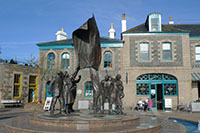
The first weekend in March I traveled to a rather unexpected destination. With two friends, I ventured to Jersey which is an island located in the English Channel. The Channel Islands, Jersey being the largest, are closer to France, but are actually part of the United Kingdom. And, yes, New Jersey is named after this small island. We decided to ride a ferry from St. Malo, France, to Jersey on a whim, and we are glad we followed through with it. Jersey was a beautiful island with friendly locals. We walked along the beach and because the tide was out, we were able to explore the outside of Elizabeth Castle. We also walked to the Jersey Tunnel Museum where we learned that the Channel Islands were occupied by the Nazis during WWII. The Jersey tunnels were used as a German hospital during the war. Winston Churchill originally wanted to save the islands from occupation but decided against it because the islands would have been hard to defend and did not give England a strategic advantage. Once England knew the islands would fall, they gave the islanders a choice: stay and be conquered or come to England. Many islanders stayed because they did not think the occupation would last very long. Unfortunately, the islands were the last place to be liberated from the Nazis because the Allies did not want to waste their resources on a location that was not important to the cause. I loved visiting the Jersey Tunnel Museum because it provided me with a unique perspective on WWII. Jersey is also known for dairy products because of their very own Jersey cows, so of course I had to try some Jersey ice cream, and I must say it was very good.
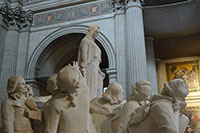
The next weekend, it was Notre Dame’s spring break, so we met up with a couple of friends in Paris who studied abroad in Angers last semester. We visited the Pantheon for the first time and saw the tombs of famous French people such as Madame Curie and Victor Hugo. We also explored the Musée de l’Orangerie where we saw a special exhibition on Franz Marc and his lesser known friend, August Macke. In that exhibition I found a painting that normally hangs in the Art Institute of Chicago, so I felt like I was home. The next day we ate lunch by the Seine and then revisited the Louvre. We entered the Louvre through a different entrance which permitted us to see things we had not seen before. I finally saw “Hammurabi’s Code” and several paintings that I had wanted to see. I had a great weekend because I was able to visit with friends and see some amazing artwork.
March was a great month, filled with many exciting new experiences. I also really started to dive into my new courses where we have been exploring French culture and contemporary events. I am excited for April because I will have a two week long break where I will be traveling throughout Europe to discover new countries.
April 2019
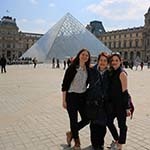
Throughout most of April, I was not actually in France because we had a two-week spring break. During the first week of break my mom and sister visited, and we traveled to Paris, Brussels, and Ghent. I showed my family my version of Paris as we did classic activities like going to the Eiffel Tower and the Louvre. We enjoyed eating French pastries and cheese and overall truly enjoyed our experience together.
In Belgium, we ate lots of waffles, fries, and chocolate. While in Brussels we followed a walking tour and learned all about the history of Brussels and the Grand Place. Apparently, Karl Marx stayed a night in the Grand Place. We of course saw the famous Manneken Pis fountain and enjoyed watching everybody laughing and admiring this tiny statue of a little boy peeing. We, of course, also visited some museums. We went to the Royal Museums of Fine Art where we saw the Old Masters Collection as well as the Rene Magritte Museum. In the Old Masters Collection, I was excited to see Jacque Louis David’s Death of Marat which is one of David’s most important paintings. It depicts the tragic murder of a French revolutionary newspaper journalist, Paul Marat, and is a perfect example of David’s mastery over propagandist imagery. Rene Magritte is a much different artist; he is a surrealist and is known for his word play. It was interesting to see his museum and to see that he actually experimented with different artistic styles.

I was highly anticipating visiting Ghent because I wanted to see the Ghent altarpiece, or the Adoration of the Mystic Lamb. We went inside St. Bavo’s cathedral and into the backroom where they keep the altarpiece and we listened to an audio guide as we stared at the masterpiece. I highly enjoyed being able to see such an important painting. In Ghent we also went to the MSK museum where we saw Theodore Gericault’s Portrait of a Kleptomaniac. There are five Portraits of the Insane and I have now seen three. It was super exciting to see “Kleptomaniac” especially because he is my favorite male portrait of the insane. We also explored the Castle of the Counts in Ghent which is just a castle created by a count to demonstrate his power over the surrounding area. It had a very interesting and dynamic audio guide and on the top of the castle there was an amazing view of Ghent. We also met up with my sister’s Belgian friend who lives in Ghent. My sister’s friend, Flo, lived in the U.S. for two years during high school. They have remained in contact and were super excited to see each other after six years.

After Belgium, my sister and my mom went back home and I moved on to Amsterdam where I met up with some Angers friends. In Amsterdam I was excited to tour the Van Gogh museum and the Rijksmuseum. At the Van Gogh Museum I had the opportunity to see the special exhibition about David Hockney’s landscapes. It was a very unique exhibition and I am very happy I was able to see it. Perhaps even more exciting, I just happened to be in Amsterdam during the 350th anniversary of Rembrandt’s death, so the Rijksmuseum had a special exhibition in which they displayed their entire collection of Rembrandts all at one time. This is the first time they have displayed all of the Rembrandts, and it is likely the only time they will ever display all of them at once. It was a great exhibition and I am super excited I was able to see it. I really admire the Rijksmuseum as a museum, they do a lot of good public outreach work, so being able to visit this museum was a dream come true. While in the Netherlands, I also walked through the famous Keukenhof gardens. I was lucky enough to be in the Netherlands during the short time period each year when the tulips are in bloom, so I had to visit the gardens. They were beautiful and it made for a very relaxing morning. We walked through the gardens and took hundreds of pictures.
Our next destination was Hamburg, Germany. We spent one day there, and the main goal was to visit the art museum, the Kunsthalle Hamburg. This museum holds the most famous German Romantic painting, Wanderer Above the Sea of Fog by Caspar David Friedrich. It was a dream come true to be able to see this amazing painting in person. After Hamburg, we spent a day in Berlin where we saw the East Side Gallery, Check Point Charlie, and three of the four museums on Museum Isle, the Pergamon Museum (where we saw the Ishtar Gate), the Altes Museum (where we saw a collection of roman antiquities) and the Neues Museum (where we saw the Head of Nefertiti). It was amazing to be able to see so much incredible artwork all in one place.
The next stop on our trip was Krakow, Poland. In Krakow we visited the Salt Mines, saw Leonardo DaVinci’s Lady with an Ermine, ate lots of pierogis and paczkis, and toured Auschwitz. Touring Auschwitz was a profound experience. I think it is truly important to visit Auschwitz if possible because it helps keep the memory of the Holocaust alive. It is vitally important that we do not forget the Holocaust so that we never allow something like that to happen again. In Auschwitz I could not comprehend the pain and suffering and death that took place there. We walked through the first gas chamber, saw the leftover hair of around 40,000 victims, the shoes and pots and pans that victims brought to the camps because they believed they were only being relocated, and the barracks where victims were kept. It was a very well-done tour and I highly recommend the experience.

From Krakow I flew to Jerusalem with two friends for Easter weekend. Jerusalem was a very unique experience. I had never been to the Middle East before, so I saw many sights I had never seen. Jerusalem is such a historic city, so it was difficult to comprehend the importance of all the buildings around us, especially in the Old City. On our first day there, Holy Saturday, we went to the Church of the Holy Sepulcher which encircles where Jesus died and was buried. It was honestly a bit of a bizarre experience. The weird part is that the church is actually shared by six different Christian denominations: Roman Catholics, Eastern Orthodox, Armenian Apostolic Church, the Ethiopian Orthodox, the Coptic Orthodox, and Syriac Orthodox. As a result, there were people from many different denominations doing their own thing, and the entire time we only saw one catholic nun and one catholic priest. After we paid our respects and prayed at both the tomb and the site of Jesus’ death, we found a Franciscan priest who happened to be in charge of the Catholic section in the church. He told us to come back at 12:30 am for vespers and then Easter mass, so we left and went back to our Airbnb until mass. We entered the church at 12:30 and found a group of religious seated in front of Jesus’ tomb. The lay people were standing behind a fence. We joined the lay people and listened to the prayers which were recited in Latin. After a period of time listening to the Vespers, we received candles which the priests handed out to lay people. We lit the candles and watched the religious as they processed around the tomb. Then the lay people joined them, and the ceremony somehow ended. We were standing around for a while trying to figure out where mass would be held until we finally asked a nearby priest and he took us to a chapel that was behind a closed door. It was very small, holding only about forty seats, we had to sit on steps in the back. It was around 2 am so it was an Easter morning mass. A bishop was presiding over the mass in Latin, but the homily was in Italian and there was a second homily given in Chinese. Mass ended, and we walked around the church for a while. The Catholics were actually yelled at to be quiet by the Greek Orthodox, so it was an odd experience. We went back to our Airbnb around 4 am and slept in late on Easter morning. When we finally did get out and about on Easter, we ate at an amazing hummus restaurant in the middle of the Muslim quarter of the Old City, and then we took a tour of the Old City where we learned about the different quarters and the rich history of Jerusalem. We saw the Western Wall, the Dome of the Rock, and the Tower of David, which actually has nothing to do with the Biblical King David.
The next day we had a few hours before our flight back to France, so we went to the top of Mt. Olives and saw the place of Jesus’ ascension into heaven as well as an amazing view of Jerusalem. We also visited the Garden of Gethsemane where Jesus was betrayed, and we entered the Church of All Nations. Then we went back to France after a very full spring break week.
Throughout my spring break, I saw a lot of amazing artwork, discovered new places, and learned about the rich history of Jerusalem. I had many incredible experiences and I am so happy that I had the opportunity to explore these places. When I came back to Angers, it was all business as we are entering our final month of school.